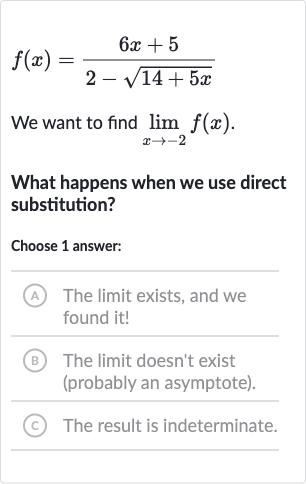AI tutor
Welcome to Bytelearn!
Let’s check out your problem:

We want to find .What happens when we use direct substitution?Choose answer:(A) The limit exists, and we found it!(B) The limit doesn't exist (probably an asymptote).(C) The result is indeterminate.
Full solution
Q. We want to find .What happens when we use direct substitution?Choose answer:(A) The limit exists, and we found it!(B) The limit doesn't exist (probably an asymptote).(C) The result is indeterminate.
- Substitute with : Substitute with in the function to see if direct substitution is possible.
- Perform calculations after substitution: Perform the calculations inside the function after substitution.
- Simplify the result of substitution: Simplify the result of the substitution to identify any issues.We have a division by zero situation, which means the function is undefined at .
- Determine behavior of the limit: Determine the behavior of the limit based on the result of direct substitution.Since we have a division by , the limit does not exist due to a potential vertical asymptote at .
More problems from Nth roots
QuestionGet tutor help
